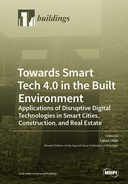Explore

Towards Smart Tech 4.0 in the Built Environment
Fahim Ullah (editor)
2023
0 Ungluers have
Faved this Work
Login to Fave
This reprint captures recent advancements in the introduction, usage, and adoption of smart and digital disruptive technologies in the built environment. It consists of 17 chapters covering a range of topics and article types. The key topics include the adoption of smart technologies, automation, and disruption in the built environment, such as wearable devices and augmented reality in construction safety, electronic process monitoring for construction tasks, digital capture of buildings through point clouds, UAVs, and LIDAR, BIM for a learning environment, underground works and wood construction, collaborative information management technologies in construction, techniques for structural health monitoring and evaluation, construction risk management, inclusive walking communities, smart spin models for cities, landfill and waste management in cities, and circular economy in construction for sustainable development.
This book is included in DOAB.
Why read this book? Have your say.
You must be logged in to comment.
Rights Information
Are you the author or publisher of this work? If so, you can claim it as yours by registering as an Unglue.it rights holder.Downloads
This work has been downloaded 78 times via unglue.it ebook links.
- 78 - pdf (CC BY) at Unglue.it.
Keywords
- 3D modelling
- Accessibility
- AEC-FM
- age-friendly
- artificial intelligence
- augmented reality
- bibliometric analysis
- BIM
- BIM education
- BIM-enabled learning
- building corrosion detection
- building damage detection
- building information modeling (BIM)
- building information modelling (BIM)
- causal loop diagram
- China Pakistan Economic Corridor
- Circular Economy
- CiteSpace
- civil infrastructure crack detection
- civil infrastructure inspection
- Collaborative technologies
- collective protection elements (CPE)
- common data environment
- Construction industry
- construction safety
- construction safety inspection
- construction supply chain
- digital tool
- electronic performance monitoring
- energy dissipation
- Geographic information systems
- Grounded theory
- History of engineering & technology
- host country attitude towards foreigners
- Image processing
- impact
- inclusive city
- industrial ecosystem
- infill panel
- information complexity
- Information management
- innovation
- input–output table
- landfill site ranking
- landfill site selection
- legal risk
- LiDAR
- Machine learning
- multi-criteria evaluation
- Multivariate statistical analysis
- n/a
- network
- new mega-subcontrolled structural system (MSCSS)
- nonlinear dynamic analysis
- occupational risk prevention (ORP)
- Penetration
- plastic deformation
- point cloud
- political risk
- process modelling
- profitability-influencing risk categories
- profitability-influencing risk factors
- project performance
- Remote sensing
- smart city industry
- social safety risk
- Solid waste
- solid waste management
- spectrum
- steel plate shear wall (SPSW)
- Sustainable development
- system dynamics
- systems thinking
- Technology, engineering, agriculture
- Technology: general issues
- TLS
- UAV
- underground works
- unmanned aerial vehicles
- Virtual learning environment
- walkability
- Wearable Device
- wearable devices
- wood construction
Links
DOI: 10.3390/books978-3-0365-7355-7Editions

